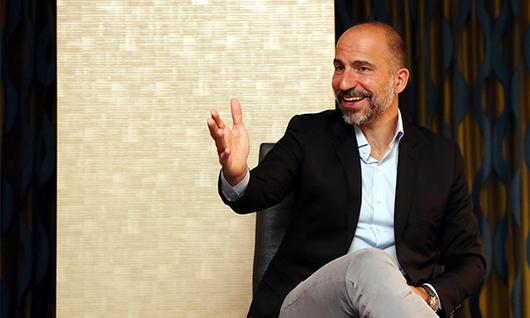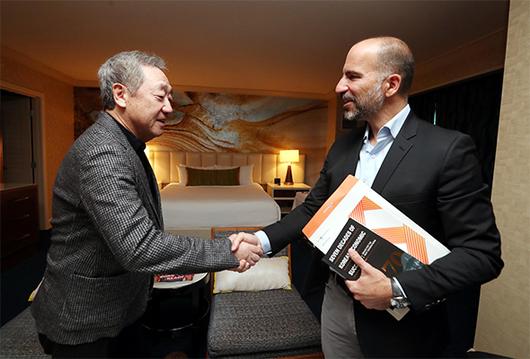 |
[Photo by Kim Jae-hoon] |
<이미지를 클릭하시면 크게 보실 수 있습니다> |
Uber suggested it was more hopeful in its second try at the South Korean market, where it was never able to launch a full-fledged business due to the diehard taxi industry, as its services could drive demand in "taxi-first countries" like South Korea and Japan by drawing international travelers, according to Dara Khosrowshahi, chief executive of the ride-hailing giant.
“In Korea, our strategy is very much to work with the government and local taxi companies,” Khosrowshahi told Chang Dae-whan, chairman of Maekyung Media Group, in his first interview with a Korean media outlet since taking over as Uber CEO in 2017.
The interview took place last week at the Mandalay Bay Hotel, Las Vegas on the sidelines of the Consumer Electronics Show.
“Korea and Japan are taxi-first countries…But utilization of their taxis is lower than they should be. I think we can bring in more international travelers to drive utilization,” Khosrowshahi said.
Uber shut down its main ride-sharing service in Korea in 2015 in the face of vehement backlash from taxi drivers. It reentered the country last year by joining hands with the local taxi industry and launching a cab-hailing service similar to Kakao T and T Map Taxi, the country’s two dominant taxi-hailing apps.
Khosrowshahi said that in most other markets, Uber has independent drivers with their own cars who can use the Uber system anytime they want to earn money.
“One thing that we learned is, while our business is global, every single city and every country is different. You can’t take a global approach. You have to localize,” he added.
Khosrowshahi also shared Uber’s broad vision going forward. “We want to be the operating system for your everyday life. Any place you want to go, anything you want in a city, we want to be your answer."
He likened it to being the “bloodflow” within a city. “A human body has to depend on veins and arteries in the bloodflow. We don’t want to build the organs or the muscles. We want to control the bloodflow, moving people and things around in a city,” he said.
 |
[Photo by Kim Jae-hoon] |
<이미지를 클릭하시면 크게 보실 수 있습니다> |
He also expounded on Uber’s aerial ambitions. Earlier this month, Uber announced its partnership with Korea’s Hyundai Motor, which would be in charge of deploying the flying cars for Uber’s promised air taxi network.
Khosrowshahi said Hyundai’s mass production capabilities were key behind its choice to partner with the Korean auto giant.
“We’re not getting into urban air mobility for the wealthy. We want to build a mass market product. And Hyundai is a mass market producer that is also capable of bringing automotive quality, safety and engineering,” he said.
Khosrowshahi said he sees the cost of urban air mobility to eventually be comparable to that of its standard UberX service. Utilization of the vehicles would be much higher because there is no traffic, and the vehicle would be shared by four or more passengers, driving cost per mile down, he explained.
He added that Uber has just started testing out this kind of “multi-modal experience” with Uber Copter, its new helicopter service launched last October between Manhattan and JFK Airport, a route that normally has terrible congestion.
“We think the future of urban mobility can’t just be though one single vehicle. Sometimes it requires multiple vehicles,” he said.
[ⓒ Maeil Business Newspaper & mk.co.kr, All rights reserved]
이 기사의 카테고리는 언론사의 분류를 따릅니다.
기사가 속한 카테고리는 언론사가 분류합니다.
언론사는 한 기사를 두 개 이상의 카테고리로 분류할 수 있습니다.
언론사는 한 기사를 두 개 이상의 카테고리로 분류할 수 있습니다.


